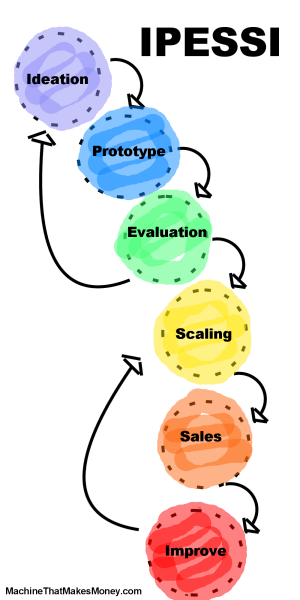 It’s called “Machine That Makes Money” because your goal, as an entrepreneur, is to build a Machine That Makes Money. This web site will help you understand the whole process. More details here.
It’s called “Machine That Makes Money” because your goal, as an entrepreneur, is to build a Machine That Makes Money. This web site will help you understand the whole process. More details here.
The machine you build will be composed of things like people, technology, equipment, investors, partners, buildings, contracts, products and ideas. You will arrange these components in whatever way you decide, and then turn on your machine. Your goal is for your new machine to produce money in your company’s bank account.
Successful machines
If you build a successful company, it will enter the pantheon of money-making machines. Your machine might succeed locally (for example a money-making blog, or a popular local coffee shop), or it might become a gigantic player in its marketplace (like Google or Facebook or Starbucks). Success is success, and it depends on your goal, because there are many different kinds of entrepreneurs with different notions of achievement:
- Some entrepreneurs just want to make a living working for themselves. They might have a deep passion for something and start a business around their passion, or they may not care what the business does as long as it makes money consistently and reliably. These entrepreneurs are often called small business owners. Their companies are often referred to as lifestyle businesses. There are about 28 million small businesses in the United States [ref].
- Some entrepreneurs want to start something local and then scale it by replicating it nationwide. This is how just about every chain works. Whether it is a chain of restaurants like Moe’s, or a chain of stores like Walmart, or a chain of storage units like Public Storage, the company normally starts with a prototype in one city, and then expands across the country by replicating.
- Some entrepreneurs want to start something new and have it explode into the public consciousness, causing some level of mass adoption across the country or around the world. Google, Facebook, Twitter, Amazon, Instagram, YouTube, Reddit and Dropbox are all examples of this process on the Internet. Redbox, FedEx, InstantPot, GoPro, Under Armour, Nike, Dropcam and Nest are examples of this process in the world of products and services.
- On the other hand, some entrepreneurs get started in a lucrative niche, and then seek resonance, dominance and growth in the niche. Atlassian is a good example of this process, where this company is dominating the niche involving communication, collaboration and documentation tools for software developers. And there are a million other examples of products in niches. Uber is an example, where their niche is putting riders and drivers together. If your company makes ovens for pizza restaurants, this is a niche. If you make an app that helps a truck driver optimize a route, this is a niche. If your software helps independent financial advisers keep track of clients, this is a niche. More examples here .
The point is, there are all kinds of entrepreneurs working across the economy at all different scales. They have all created different Machines That Make Money, big and small.
Using Machine That Makes Money
Whatever kind of entrepreneur you are, Machine That Makes Money is here for you. What you will find here are insightful articles, helpful advice, and answers to your questions about launching and growing your startup/venture/business/enterprise. We will use the IPESSI process and work through the steps so that you can start with nothing and create your own Machine That Makes Money.
Here are the basic steps:
- Step #0 – Get into the Mindset of an entrepreneur. Once you wrap your head around what it means to be an entrepreneur, you can start IPESSI…
- Step #1 – Recognize a pain point or opportunity in a marketplace where value might be created, and imagine a solution. (Ideation)
- Step #2 – Quickly and efficiently create a prototype/MVP that encapsulates your core value proposition and demonstrates it to potential customers. Iterate quickly based on feedback until you have something that people seem to like. (Prototyping)
- Step #3 – Evaluate whether there is sufficient interest/demand for the product, whether you can reach the audience efficiently, and whether the idea can be profitable. Is the idea worthy of further effort? If not, then stop. Re-deploy the resources on a new idea. Otherwise, move ahead. (Evaluation)
- Step #4 – If the idea is worth pursuing, apply more resources, then finalize and launch the v1.0 product. (Scaling)
- Step #5 – Aggressively promote and sell the product to make money. All of the development work is done – now it is time to reap the reward. (Sales)
- Step #6 – Iteratively improve the product to increase market share and growth potential. (Improvement)
Get Going Today!
Here are four good ways to proceed from here:
- If you want to understand how entrepreneurs make millions of dollars, and you want to understand the art of thinking big, read: 1) How Startup Stock Creates Transcendental Wealth, 2) Prototyping a $1 billion startup, 3) How to Think Big about Your Startup
- If you are brand new to this, and if you aren’t even sure what the word “entrepreneur” means, start with this article: How Entrepreneurship Works
- If you are just starting out and would like to learn how to become an entrepreneur, head to the Table of Contents. You can cherry pick points of interest, or start at the top and work down.
- If you have questions, head over to the forum and ask away!